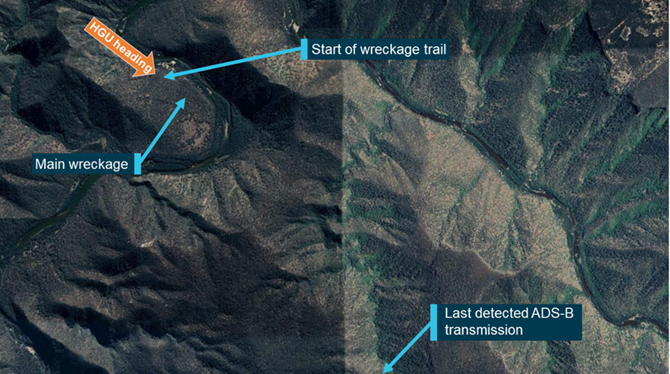R44 In-flight Break-up Highlights Risk of Extreme Teetering & Mast Bumps

A Robinson R44 helicopter broke up in flight as a result of extreme teetering, either due to turbulence or inappropriate control inputs, an Australian Transport Safety Bureau (ATSB) investigation has concluded.
A search was launched after the Robinson R44 helicopter, flown by a student and instructor pilot, failed to return from a training flight from Goulburn Airport, in the Southern Tablelands region of New South Wales, on the afternoon of December 2, 2020.
Wreckage of the helicopter was found later that evening in the Bungonia State Conservation Area, approximately 31 km east of Goulburn. The accident site was also 4 km north-west of the helicopter’s last recorded ADS-B transmission, which indicated it was descending into a valley.
The Robinson A44 helicopter’s engine and fuselage had been exposed to fire, which had self-extinguished before emergency services arrived. Both pilots were fatally injured.
ATSB investigators surveyed the wreckage trail and main wreckage site and, despite fire damage, recovered and examined several components of the helicopter’s main rotor.
Examinations confirmed a mast bump had occurred, and that the helicopter had subsequently broken up in flight.
“Mast bumping is where the inboard end of the main rotor blade contacts the helicopter’s main rotor shaft,” ATSB Director Transport Safety Stuart Macleod explained.
In R44 helicopters, this can generally be identified by extensive damage to the teeter stops and varying degrees of damage to the main rotor shaft.
“The semi-rigid – or teetering – main rotor design of the R44 and several other popular helicopters relies on rotational force to lift the blades off the droop stops on the rotor hub during flight,” Mr Macleod said.
“During normal operation, the rotor is free to teeter and flap around its designed flight axis via the teeter hinge, while polyurethane teeter stops limit the degree of teetering.”
A mast bump can occur when extreme teetering causes the rotor blades to exceed this allowance, and contact the rotor hub at a high speed.
“The ATSB investigation found that, while flying in the vicinity of the valley, the helicopter entered a low-G condition due to turbulence, inappropriate control inputs, or a combination of both,” Mr Macleod said.
“Low-G conditions can be catastrophic for helicopters with semi-rigid rotor heads. A pilot’s ability to recover from low-G remains uncertain, and would be dependent on airspeed and time available. Pilots must therefore avoid low-G situations.”
Mr Macleod noted pilots should make a careful study of terrain, forecasts and observations applicable to a proposed flight, to identify in advance any significant weather or mechanical turbulence, and avoid flying in these conditions.
“Pilots should avoid flying downwind of hills, ridges or other potential sources of turbulence, particularly during changing or unpredictable weather conditions, and should use slow and small control inputs when encountering turbulence,” Mr Macleod said.
The investigation report also urges operators to consider the benefits of installing recording devices on their helicopters.
“While the fire would likely have prevented data recovery in this case, the inclusion of readily-available cockpit video recorders on helicopters with semi-rigid rotor heads would provide valuable insights into low-G mast bumping events, which could help prevent future occurrences,” Mr Macleod concluded.
Since the occurrence, Robinson has introduced cockpit video/audio recorders as standard equipment on new R44s, having previously been available on the larger R66 models. The recorders are currently optional on the smaller R22s, but will also become standard on these models in 2023, with retrofit kits made available.
Read the ATSB report: AO-2020-061 In-flight break-up involving Robinson R44 Raven I, VH-HGU 31 km east of Goulburn Airport, New South Wales, on 2 December 2020.
Founded in 1988, the TapRooT® Root Cause Analysis System solves hurdles every investigator faces
TapRooT® Root Cause Analysis Training System takes an investigator beyond his or her knowledge to think outside the box. Backed with extensive research in human performance, incident investigation, and root cause analysis, TapRooT® is a global leader in improved investigation effectiveness and productivity, stopping finger-pointing and blame, improving equipment reliability, and fixing operating problems.
System Improvements, the creator of the TapRooT® System, has a team of investigators and instructors with years of extensive training ready to offer assistance worldwide. We also offer ongoing support to our clients through free newsletters and root cause tip videos, the root cause analysis blog, and our annual Global TapRooT® Summit.
Register for a TapRooT® RCA Course
Register for one of our TapRooT® courses. Among all the TapRooT® Training courses, we offer a 2-Day TapRooT® Root Cause Analysis Course and a 5-Day TapRooT® Advanced Root Cause Analysis Team Leader Course.
Contact us or call us at 865.539.2139 about having a course at your site or for further root cause analysis training opportunities. We’re here to help you find solutions.



